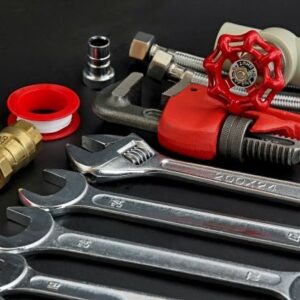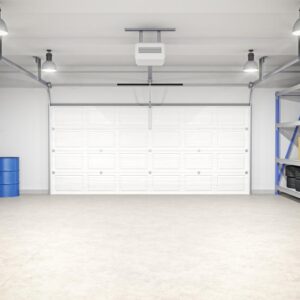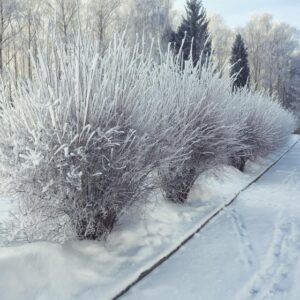It looks beautiful when winter snow blankets your home and landscape. However, the snow’s weight builds up on your roof and trees and can cause damage over time if you don’t remove it. While you may be used to shoveling and blowing snow from your sidewalks and driveways, it’s easy to forget about the snow buildup in other places. So, after you have cleared your walkways this winter, take some extra time to remove snow and ice from your roof and trees.
How to Remove Snow from Rooftops
Step 1: Assess the Situation
Determine the best way to safely remove the snow from the roof. Decide where you should place the ladder for the best access to your roof. Remember, when you remove snow from your house or garage roof it has to go somewhere. Be mindful not to drop it on walkways you’ve already cleared or on other structures unless there’s no other option.

Safety Alerts!
Familiarize yourself with basic ladder safety procedures. Be wary of placing the ladder on any slick, icy spots on the ground. Be very careful around overhead electrical wires, especially when moving ladders around or near the locations of service lines attached to the house. Invest in an adjustable ladder stabilizer and/or have someone hold the ladder for you.
Never step onto an icy or snowy roof to clear off snow.
Helpful Tip
Try to keep your roof clear of branches, leaves and other debris that might keep snow and ice from sliding off the roof.
Step 2: Choose the Right Snow Removal Tool
Pick a snow removal tool. The best tool for effectively removing snow is a snow rake or shovel. They have extended handle lengths for hard-to-reach areas, such as a large roof. If you have a garage or shed with a low roof, a snow rake or shovel might be all you need.
Step 3: Start Clearing the Heavy Snow
Use your snow rake to begin clearing snow where it is heaviest. Pull the snow down towards the edge of the roof and let it fall to the ground. Be careful not to pile it in gutters. However, if gutters do fill up, remove the snow using a gutter scoop, small shovel or a similar tool.
Don’t worry about clearing the roof completely. As long as the bulk of the snow has been removed, its weight is no longer a potential problem.

Safety Alert!
Avoid potential falls; do not overreach with your rake or shovel. If you can’t reach an area comfortably, try moving your ladder to another safe location. If areas are impossible to reach, skip them. Don’t climb onto the roof for extra reach.
Step 4: Keep Ice & Snow Out of Gutters
Stop ice from forming in gutters by keeping them clear. Hopefully, you took time in the fall to clean out your gutters by removing sticks, leaves and other debris that might cause water to dam up and freeze once the temperature drops. If you haven’t, use a gutter scoop to remove any compacted debris in your gutters. Attach a bucket to your ladder with a wire hook for more efficient debris collection and for holding your tools. Start at the downspouts and work your way in, but avoid pushing debris together as this can create more clogs.
Safety Alert!
Wear heavy gloves for protection. Sharp objects such as thorns and roofing nails can end up in gutters.
Clogs also can happen where the downspout connects to the gutter. Remove the elbow joint and inspect all parts for clogs. If the blockage is out of reach, de-clog from the bottom up to avoid packing the clog tighter—pull down the downspout and use a broom handle to clear the blockage.

If you already have significant amounts of ice in your gutters, you’ll need to break it up to get it out. Not only does ice block the flow of gutters, the weight of the ice can bend and warp gutters, and potentially weigh them down enough so they break or are pulled down.
Use a chisel or similar type of sturdy, sharp object to break up the ice. Do it as gently as possible to avoid any damage to your gutters. Once you’ve broken up the ice, scoop most of it out with a gutter scoop or small shovel.
How to Remove Snow from Trees
After a heavy snow, brave the winter cold and do your best to remove as much snow as possible from the tree branches in your yard. The excess weight on the tree branches can cause them to bend or break, allowing them to fall on your house or on electrical wires. Using a broom or a similar tool, employ an upward, sweeping motion to remove snow from the branches. Gently shaking the branches or tapping the tree trunks may also help to remove snow. If the snow is frozen on the branches and will not brush off easily, then let it melt naturally to avoid damage to the tree.

Helpful Tip
Remove snow from tree branches as soon as possible. The longer the snow remains on your trees’ branches, the more likely it is to freeze on the branches and cause damage.
If tree limbs break or sag under the weight of ice or snow, it’s best to have them removed as soon as the weather permits. Also, the tree will be able to heal the wound better in spring if the wound has clean edges as opposed to ragged tears. Remove broken branches by hand or use a handsaw or hatchet if necessary. Hanging branches can be a danger to passing pedestrians. Put all branches and plant material in lawn bags.
That’s it! You’ve removed snow from your roof and trees and decreased the potential for damage.
Project Shopping List
Here’s what you’ll need to complete this project successfully.












